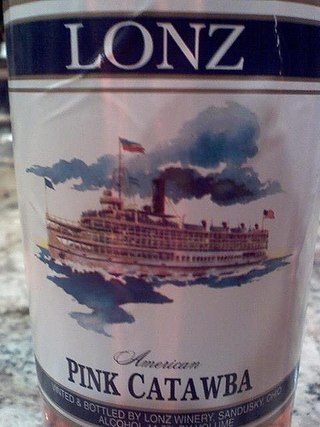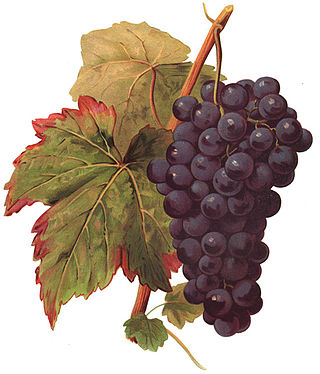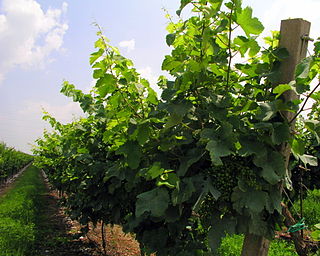Related Research Articles

Grüner VeltlinerGerman:[ˈɡʁyːnɐfɛltˈliːnɐ] ) is a white wine grape variety grown primarily in Austria, Hungary, Slovakia, and the Czech Republic. The leaves of the grape vine are five-lobed with bunches that are long but compact, and deep green grapes that ripen in mid-late October in the Northern Hemisphere.

The Muscat family of grapes includes over 200 grape varieties belonging to the Vitis vinifera species that have been used in wine production and as raisin and table grapes around the globe for many centuries. Their colors range from white, to yellow, to pink to near black. Muscat grapes and wines almost always have a pronounced floral aroma. The breadth and number of varieties of Muscat suggest that it is perhaps the oldest domesticated grape variety, and there are theories that most families within the Vitis vinifera grape variety are descended from the Muscat variety.

Aligoté is a white grape used to make dry white wines, especially in the Burgundy region of France where it was first recorded in the 18th century. Since it is tolerant to cold, this variety is also cultivated in Eastern European countries. In 2004, it was the 22nd most planted vine variety in the world at 45,000 hectares.

Catawba is a red American grape variety used for wine as well as juice, jams and jellies. The grape can have a pronounced musky or "foxy" flavor. Grown predominantly on the East Coast of the United States, this purplish-red grape is a likely a hybrid of the native American Vitis labrusca and the Vitis vinifera cultivar Semillon. Its exact origins are unclear but it seems to have originated somewhere on the East coast from the Carolinas to Maryland.

The wine industry of Ukraine is well-established with long traditions. Several brands of wine from Ukraine are exported to bordering countries, the European Union, and North America. Amid the 2022 Russian invasion of Ukraine Ukrainian winemakers continued to work and produce wine.

St. Laurent is a highly aromatic dark-skinned wine grape variety grown in cool climate regions of central Europe, mainly Austria and the Czech Republic. Its origin is uncertain, but the long-held belief that it is related to Pinot noir has been confirmed by DNA analysis, which shows it is an offspring of Pinot noir and a second parent, possibly Savagnin.

Torrontés is a white grape variety, mostly produced and known in Argentina, producing fresh, aromatic wines with moderate acidity, smooth texture and mouthfeel as well as distinctive peach and apricot aromas on the nose. Three Torrontés varieties exist in Argentina: Torrontés Riojano, the most common, Torrontés Sanjuanino, and Torrontés Mendocino. It is primarily Torrontés Riojano that has received attention for the quality of its wines, and is the variety used for most Argentine wines simply labeled Torrontés.

Kazakh wine is wine made in Kazakhstan. The roots of the Kazakh wine industry can be traced to the 7th century AD when grapevines were brought to the region from neighboring Uzbekistan and China. While only around 4% of the land in Kazakhstan is ideally situated for viticulture, the country does manage to produce over 6.2 million gallons of wine annually from 32,120 acres (13,000 ha). Buoyed by its mineral wealth, the country is an enthusiastic consumer of wine but must import 80% of the 30 m bottles it drinks.

Baden is a region (Anbaugebiet) for quality wine in Germany, and is located in the historical region of Baden in southwestern Germany, which today forms part of the federal state of Baden-Württemberg. Under German wine legislation, Baden and Württemberg are separate wine regions.
Baroque is a white French wine grape planted primarily in South West France around the Tursan region. It can make full bodied wines with nutty flavors. Ampelographers suspect that the grape maybe a crossing of Folle Blanche and Sauvignon blanc.
Chasan is a white French wine grape variety grown primarily in the Languedoc wine region. According to the Vitis International Variety Catalogue, the variety is a crossing of Listan and Pinot. However, some sources describe the grape as a crossing between Listan and Chardonnay. All sources agree, however, that the variety was created in 1958 by Paul Truel at the Institut National de la Recherche Agronomique (INRA) - Unité Expérimentale du Domaine de Vassal & Montpellier SupAgro. One possible source for the confusion of the grapes parentage is that a common synonym of several clones of Chardonnay are sometimes listed as Pinot Chardonnay and Chardonnay, itself, was a crossing of Pinot and the obscure French wine grape Gouais blanc.
Dimyat is a white Bulgarian wine grape. It is one of Bulgaria's most widely planted white grape varieties, second only to Rkatsiteli. Wines made from this variety are noted for their perfume aromas. While some ampelographers believe that the variety is indigenous to Bulgaria, legends have developed around Dimiat being named after a city in the Nile Delta and was brought back to Europe by Crusaders in the Middle Ages.
Flora is the name of two unrelated varieties of grape, one white and one red, both of United States origin.

Caladoc is a red French wine grape variety planted primarily in the southern wine regions such as the Languedoc. The grape is a crossing of Grenache and Malbec created by Paul Truel in 1958 at Institut National de la Recherche Agronomique (INRA).

Glera is a white variety of grape of Italian origin, possibly from the village, Prosecco. The variety was formerly mostly referred to as Prosecco, but in the EU was renamed "Glera" in 2009 to make room for the protection of "Prosecco" as the name of the Italian geographically-protected wine.

Incrocio Manzoni or Manzoni grapes is a family of grape varieties named after Professor Luigi Manzoni (1888-1968) of Italy's oldest school of oenology located in Conegliano, in the Veneto region. Manzoni created the new grape varieties by selecting, crossing and grafting vines from various vineyards during the 1920s and 1930s. The family includes both white and red grape varieties. Although most Manzonis are grown in northeastern Italy, they are mainly grown in the Piave area of Province of Treviso and are only now starting to be sold commercially in Europe and the United States.

Olmo grapes are wine and table grape varieties produced by University of California, Davis viticulturist Dr. Harold Olmo. Over the course of his nearly 50-year career, Dr. Olmo bred a wide variety of both grapes by means of both crossing varieties from the same species or creating hybrid grapes from cultivars of different Vitis species.
Taminga is white Australian wine grape variety that was developed in the late 20th century by viticulturalist and grape breeder Alan J. Antcliff at CSIRO. It is a cross of a previously created crossing Merbein 29-56 and the Vitis vinifera variety Traminer Rot (Gewürztraminer) Like Tarrango, a 1960s crossing between Touriga Nacional and Sultana, Taminga was bred to maintain high acidity levels while growing in hot Australian vineyards. Early results from Taminga show that it can ripen consistently in different vineyard location and produce wines that wine expert Jancis Robinson describes as "commercially acceptable.
Cabernet blanc is a white German and Swiss wine grape variety that is a crossing of the French wine grape Cabernet Sauvignon and Regent. The grape was bred by Swiss grape breeder Valentin Blattner in 1991. Cabernet blanc has strong resistance to most grape disease including botrytis bunch rot, downy and powdery mildew and tends to produce loose clusters of small, thick-skinned grape berries which can hang on the vine late into the harvest season to produce dessert wines. Today the grape is found primarily in the Palatinate wine region of Germany with some experimental plantings in Spain and the Netherlands. In France, in the Languedoc, Domaine La Colombette is heavily investing in PIWI grapes. Amongst others the Cabernet Blanc in their cuvée "Au Creux du Nid", is gaining wide acclaim.
References
- ↑ J. Robinson Jancis Robinson's Wine Course Third Edition pg 141 Abbeville Press 2003 ISBN 0-7892-0883-0
- 1 2 "Rubinovyi Magarcha". Vitis International Variety Catalogue . Archived from the original on 2012-04-22. Retrieved 2010-01-30.